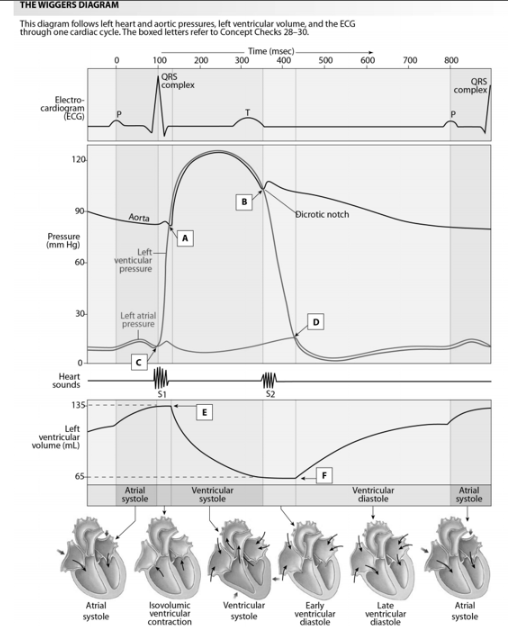Using the figure below (Fig. 14.18 from your text), calculate the following values:

A) Heart rate
B) Stroke volume
C) Cardiac output
D) Mean Arterial PressureWhat will be an ideal response?
A) (1 cycle/800 msec) × (1000 msec/sec) × (60 sec/min) = 60,000 cycles/800 min
= 75 cycles (or beats)/min
B) Stroke volume = EDV - ESV = 135 mL - 65 mL = 70 mL/beat
C) Cardiac output = HR × SV = 75 beats/min x 70 mL/beat = 5250 mL/min or 5.25 L/min
D) Mean Arterial Pressure = (DP +DP + SP)/3 = (85 + 85 + 120)/3 = 290/3 = 96.7 mm Hg
or
MAP = DP + 1/3 (SP-DP) = 85 + 1/3 (120-85) = 85 + 1/3 (35) = 85 + 11.7 = 96.7 mm Hg
You might also like to view...
Pain from the kidneys is usually referred by way of the:
A. autonomic pathways to the inferior pelvic organs. B. sympathetic pathways to the T10-T12 dermatomes. C. somatic pathways to the left shoulder. D. parasympathetic pathways to the T1-T2 region.
What part of the body does the masseter move?
a. head and neck b. upper extremities c. trunk of the body d. lower extremities
Which of the following is not a part of the diencephalon?
A) Hypothalamus B) Posterior pituitary gland C) Thalamus D) Anterior pituitary gland
Ball and socket joints allow movement in all three planes and are the only ________ joints in the body.
Fill in the blank(s) with the appropriate word(s).